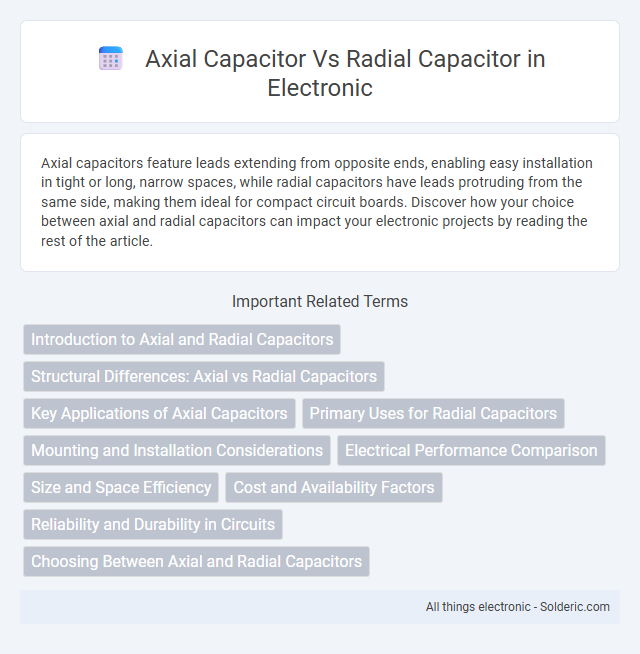Axial capacitors feature leads extending from opposite ends, enabling easy installation in tight or long, narrow spaces, while radial capacitors have leads protruding from the same side, making them ideal for compact circuit boards. Discover how your choice between axial and radial capacitors can impact your electronic projects by reading the rest of the article.
Comparison Table
| Feature | Axial Capacitor | Radial Capacitor |
|---|---|---|
| Lead Orientation | Leads extend from both ends along the same axis | Leads extend from one side (bottom) |
| Mounting Style | Ideal for through-hole, inline mounting | Commonly used for through-hole, vertical mounting |
| Size & Shape | Elongated cylindrical shape | Compact, shorter cylindrical shape |
| Application | Used where space allows lengthwise installation | Used in compact PCB layouts with vertical space |
| Mechanical Stability | Good vibration resistance due to lead distribution | Stable, but less vibration absorption than axial types |
| Common Types | Film capacitors, Electrolytic (specialized) | Electrolytic capacitors, ceramic capacitors |
Introduction to Axial and Radial Capacitors
Axial capacitors feature leads extending from opposite ends of a cylindrical body, making them suitable for mounting in line with circuit boards in longitudinal orientations. Radial capacitors have both leads emerging from the same side, allowing for compact vertical mounting on printed circuit boards with efficient space utilization. Selection between axial and radial capacitors depends on factors such as circuit layout, mechanical stability, and space constraints in electronic designs.
Structural Differences: Axial vs Radial Capacitors
Axial capacitors feature leads extending from both ends of the cylindrical body, allowing them to lie flat against circuit boards, while radial capacitors have both leads protruding from one end, enabling vertical mounting. This structural difference affects your PCB layout, with axial types often preferred for space-saving designs requiring horizontal placement, and radial types suited for compact, vertical stacking. The choice between axial and radial capacitors impacts assembly methods, soldering processes, and overall circuit reliability.
Key Applications of Axial Capacitors
Axial capacitors are widely used in applications requiring compact, low-inductance components for high-frequency circuits, such as audio equipment, signal processing, and precision timing devices. Their cylindrical shape with leads extending from each end enables easy mounting on printed circuit boards (PCBs) in tight spaces, making them ideal for space-constrained electronics. Your choice of axial capacitors enhances circuit stability and performance in applications demanding reliability under mechanical stress and vibration.
Primary Uses for Radial Capacitors
Radial capacitors are primarily used in power supply filters, audio equipment, and general-purpose electronic circuits due to their compact size and efficient lead configuration. Their lead placement allows for easy mounting on printed circuit boards (PCBs) with a consistent orientation, making them ideal for high-density assemblies and automated manufacturing. Radial capacitors excel in applications requiring stable capacitance and reliable performance across varying temperatures and voltages.
Mounting and Installation Considerations
Axial capacitors feature leads that extend from both ends, making them ideal for mounting in linear or tight spaces where a low profile is necessary, often used in through-hole PCB designs requiring minimal height. Radial capacitors have both leads protruding from one side, which facilitates easier automated mounting and soldering on vertically oriented boards, enhancing production efficiency. Choosing between axial and radial capacitors depends on PCB layout, space constraints, and assembly methods to ensure optimal mechanical stability and electrical performance.
Electrical Performance Comparison
Axial capacitors typically offer lower Equivalent Series Resistance (ESR) and better frequency response, making them suitable for high-frequency filtering applications. Radial capacitors usually provide higher capacitance values with a compact footprint, ideal for bulk energy storage in power supply circuits. The choice between axial and radial capacitors depends on circuit requirements for stability, size constraints, and electrical performance like ripple current handling and thermal dissipation.
Size and Space Efficiency
Axial capacitors feature leads extending from each end, enabling a more compact and low-profile design suitable for tight spaces, while radial capacitors have both leads on one side, resulting in a taller footprint but a smaller board area footprint. Radial capacitors generally occupy less circuit board space vertically, making them ideal for surface-mount or densely populated PCBs where height is less constrained. Axial capacitors offer superior mechanical stability in applications requiring vibration resistance, though they may require more board layout consideration due to their elongated shape.
Cost and Availability Factors
Axial capacitors generally cost more than radial capacitors due to their specialized design and limited production volume, making them less common and harder to source. Radial capacitors offer better availability and cost-effectiveness because they are widely manufactured for mass-market applications, driving down price and ensuring easy procurement. Manufacturers and distributors typically stock radial capacitors in larger quantities, contributing to lower lead times and more competitive pricing compared to axial capacitors.
Reliability and Durability in Circuits
Axial capacitors offer improved reliability in circuits due to their robust construction and ability to withstand mechanical stress, making them ideal for applications with frequent vibration or movement. Radial capacitors, while more compact and cost-effective, may have reduced durability under harsh conditions due to their different lead arrangement and susceptibility to bending stress. Choosing the right capacitor type can enhance your circuit's longevity and consistent performance by matching the component to the mechanical and environmental demands.
Choosing Between Axial and Radial Capacitors
Choosing between axial and radial capacitors depends on your circuit design and space constraints. Axial capacitors have leads extending from both ends, making them ideal for through-hole mounting in narrow spaces, while radial capacitors feature leads on one side, offering a more compact footprint for PCBs. Assess your board layout and mechanical stability requirements to determine which capacitor type best fits your application.
axial capacitor vs radial capacitor Infographic

 solderic.com
solderic.com